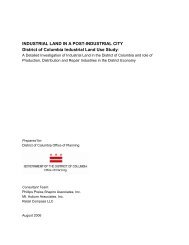An Alternative Future for the North East Mission Industrial Zone
An Alternative Future for the North East Mission Industrial Zone
An Alternative Future for the North East Mission Industrial Zone
You also want an ePaper? Increase the reach of your titles
YUMPU automatically turns print PDFs into web optimized ePapers that Google loves.
<strong>Mission</strong> Coalition <strong>for</strong> Economic Justice & Jobs (MCEJJ)<br />
Appendix A.24<br />
3. Don’t rezone from <strong>Industrial</strong> to residential. Keep existing uses as is. (Including <strong>the</strong> type of<br />
zoning that allowed a mix of fine-grained uses to occur in <strong>the</strong> first place.)<br />
4. Live/Work spaces should be real Live/Work spaces, not apartments. Establish checks through<br />
<strong>the</strong> business license or a system to prove work is occurring in <strong>the</strong> space.<br />
5. Do not create non-con<strong>for</strong>ming uses as in city’s “<strong>Alternative</strong> B”.<br />
6. Maintain /Create clear parking standards <strong>for</strong> new development.<br />
Summary: Group L<br />
Group L consisted of a mix of residents, property and business owners and one advocate with <strong>the</strong> <strong>Mission</strong><br />
<strong>An</strong>ti-Displacement Coalition. Several of <strong>the</strong> participants fell into more than one of <strong>the</strong> above categories.<br />
The group devoted considerable time to discussing whe<strong>the</strong>r or not zoning was an appropriate tool <strong>for</strong> shaping<br />
<strong>the</strong> NEMIZ’ future. Early on in this discussion, it became clear that Group L was divided into two factions<br />
with divergent opinions on this issue. On one side, a slight majority of participants favored a ‘hands-off’<br />
approach to regulating land use in <strong>the</strong> NEMIZ, which would not include strong provisions <strong>for</strong> <strong>the</strong> protection<br />
of PDR uses, but ra<strong>the</strong>r allow <strong>for</strong> mixed-use development to occur throughout <strong>the</strong> area. Land use decisions<br />
would be largely driven by property owners’ decisions ra<strong>the</strong>r than by zoning as established by <strong>the</strong> Planning<br />
Department. On <strong>the</strong> o<strong>the</strong>r side were two participants who strongly advocated <strong>the</strong> need <strong>for</strong> protecting PDR<br />
uses in <strong>the</strong> neighborhood. Their position was based on <strong>the</strong> notion that clear rules <strong>for</strong> regulating land use in<br />
<strong>the</strong> NEMIZ had been lacking <strong>for</strong> years to <strong>the</strong> effect that numerous businesses providing jobs <strong>for</strong> residents<br />
(more specifically <strong>the</strong> Latino population) of <strong>the</strong> NEMIZ and <strong>the</strong> <strong>Mission</strong> at large had been eliminated in <strong>the</strong><br />
past, while o<strong>the</strong>rs were still being threatened by <strong>the</strong> influx of more non-PDR uses. The first sub-group<br />
expressed opposition to and suspicion about <strong>the</strong> zoning ef<strong>for</strong>ts by <strong>the</strong> San Francisco Planning Department,<br />
whose intentions were seen as a threat to gains people felt <strong>the</strong> NEMIZ had made toward developing from an<br />
unsafe, decaying neighborhood to a safer and more livable place based on <strong>the</strong> rise of new residential and<br />
mixed-use projects. The group also saw <strong>the</strong> City’s zoning ef<strong>for</strong>t as interfering with <strong>the</strong> right of property<br />
owners to decide about <strong>the</strong> most beneficial land use <strong>for</strong> <strong>the</strong>ir property. The second group on <strong>the</strong> o<strong>the</strong>r hand,<br />
was generally in agreement with <strong>the</strong> Planning Department’s intention of protecting PDR uses and <strong>the</strong><br />
introduction of clearer rules pertaining to land use and <strong>the</strong> tighter control of non-PDR uses pushing into <strong>the</strong><br />
area.<br />
Toward <strong>the</strong> end of <strong>the</strong> discussion <strong>the</strong> two groups came closer in <strong>the</strong>ir views on several of <strong>the</strong> discussion points<br />
with some basic differences remaining. Proponents of a ra<strong>the</strong>r fluid, largely mixed-use driven future of <strong>the</strong><br />
NEMIZ acknowledged <strong>the</strong> importance of jobs to <strong>the</strong> <strong>Mission</strong> as a whole and agreed to <strong>the</strong> need <strong>for</strong> some<br />
‘rules’ about <strong>the</strong> incompatibility of certain uses. They also agreed in concept to <strong>the</strong> need of limiting some uses<br />
such as destination restaurants and commercial development to protect <strong>the</strong> viability of o<strong>the</strong>r parts of <strong>the</strong><br />
<strong>Mission</strong> (specifically <strong>Mission</strong> Street as a commercial corridor). These participants remained suspect, however,<br />
of <strong>the</strong> concept of wholesale PDR protection as proposed by <strong>the</strong> City. Exemplary <strong>for</strong> <strong>the</strong> difference between<br />
<strong>the</strong> two groups was <strong>the</strong> discussion of potential land uses on a vacant parcel owned by a property owner at <strong>the</strong><br />
table. While <strong>the</strong> property owner desired <strong>the</strong> flexibility of being able to build residential mixed-use next to a<br />
PDR-use, <strong>the</strong> proponents of PDR-protective zoning countered that, in general, most property owners knew<br />
ahead of time that <strong>the</strong>y were buying in an ‘industrial’ area and should not have expected <strong>the</strong> later ability to<br />
implement non-compatible (but more profitable) land uses.<br />
Overall, it was clear that all participants sincerely argued <strong>for</strong> what <strong>the</strong>y thought best <strong>for</strong> <strong>the</strong> NEMIZ or <strong>the</strong><br />
larger <strong>Mission</strong> neighborhood. The key difference lay in <strong>the</strong> level of intervention imposed on <strong>the</strong> flexibility of












